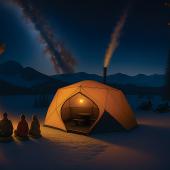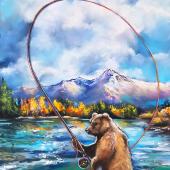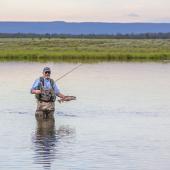Flight Pattern
Q&A with raptor researcher Steve Hoffman.
Steve Hoffman is more than a bird conservationist—he’s a pioneer who climbed mountains in the ’70s, first discovering the West’s raptor-migration flyways. These days, Hoffman still ascends those same mountains, looking to birds to help solve our most pressing conservation issues. O/B caught up with him recently in Bozeman.
O/B: What sparked your interest in raptors?
SH: Raptors are environmental barometers at the top of the food chain. For that matter, all birds are pretty good environmental indicators, because they’re easy to see and they occupy every different kind of habitat. Whether it be marine, terrestrial, mountain, desert, grassland, or wetland, birds are in all that stuff. Depending on how each species is doing, that tells us how well we’re being stewards of those habitats.
O/B: Could you describe the journey of the raptors that migrate through the Bridgers?
SH: It depends on the species. You have peregrine falcons that breed around here but also breed all the way up to the Arctic Circle, and they winter as far south as Patagonia, the southern tip of South America. We’re talking a round-trip of 15,000 miles in one year. They go over 7,000 miles to where they winter, and 7,000 miles back to breed. They may fly 300 miles in a day depending on the conditions.
O/B: Then, do Montana’s raptor-conservation efforts affect those of other countries?
SH: Anything that we would do for habitats here may affect their ability to find food as they migrate through, but wherever they winter, somebody’s got to take care of those places, too. If we’re going to be effective with bird conservation as a whole, we have to take care of their breeding grounds. We have to take care of their migratory flyways and staging areas and their winter grounds. That means it’s got to be an international effort. We have to talk to Argentina. If they start poisoning the locusts down there, the hawks aren’t going to survive the winter to come back here and nest. The greatest challenge of bird conservation, really, is taking care of all the parts of their annual cycle.
O/B: Was that part of your inspiration to launch your new endeavor, Merlin Birding Tours?
SH: Partly. A lot of the birds in Montana winter all over Mexico. So we really need stronger relationships with our Mexican friends to do conservation together. A lot of what I want to do with Merlin Tours is not just to be a recreational endeavor, but let’s work together to take care of things, and let’s leave some money behind. When we go to Veracruz City, they’re going to use some of the income generated from our trip down there to do conservation work.
O/B: Where can the average Bozemanite enjoy this fall’s raptor migration?
SH: The Bridgers, and that’s easy: you just go to Bridger Bowl and walk to the top. And I’ve discovered a new flyway just northwest of here, in the Big Belts. We’re counting even more golden eagles there, and everybody’s welcome to come up there, too. The peak for golden eagles is the first three weeks of October.
O/B: What do you wish all of your birding organizations could say to Bozeman?
SH: I know Montana is more environmentally conscious than a lot of places, but we shouldn’t take what we have lightly. We’re going to need to work really hard for the next century to hold on to what we have. Even if we are successful in reversing climate change, there’s a whole bunch of other issues, including everybody wanting to move here. It’s going to take a commitment from everybody.
Steve Hoffman lives in Bozeman. He’s the former executive director of Montana Audubon and the founder of HawkWatch International and Merlin Birding Tours.












